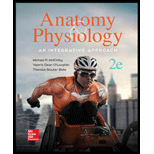
Anatomy & Physiology: An Integrative Approach
2nd Edition
ISBN: 9780078024283
Author: Michael McKinley Dr., Valerie O'Loughlin, Theresa Bidle
Publisher: McGraw-Hill Education
expand_more
expand_more
format_list_bulleted
Concept explainers
Question
Chapter 9, Problem 16DYKB
Summary Introduction
To describe:
The movements of adduction, abduction, pronation, and supination. Also, compare them.
Concept introduction:
Movement is defined as the ability of organisms to move from one place to another. Movements can be a type of ciliary movement, flagellar movement, muscular movement, and so on.
Expert Solution & Answer
Want to see the full answer?
Check out a sample textbook solution
Students have asked these similar questions
Describe the following movements: flexion, extension, abduction, adduction, supination, pronation, dorsiflexion, plantar flexion, inversion, and eversion.
Distinguish among rotation, circumduction, pronation, andsupination. Give an example of each
Compare and contrast the paired movements of flexion and extension with adduction and abduction.
Chapter 9 Solutions
Anatomy & Physiology: An Integrative Approach
Ch. 9.1 - What is the relationship between mobility and...Ch. 9.1 - Are all fibrous joints also synarthroses? Explain...Ch. 9.2 - Prob. 3WDYLCh. 9.2 - Prob. 4WDYLCh. 9.2 - Prob. 5WDYLCh. 9.3 - Prob. 6WDYLCh. 9.3 - Prob. 7WDYLCh. 9.4 - What are the basic characteristics of all types of...Ch. 9.4 - Prob. 9WDYLCh. 9.4 - Prob. 10WDYL
Ch. 9.5 - What is the difference between the effort arm and...Ch. 9.5 - Prob. 12WDYLCh. 9.6 - Prob. 13WDYLCh. 9.6 - How do flexion and extension differ? What...Ch. 9.6 - Prob. 15WDYLCh. 9.6 - Prob. 16WDYLCh. 9.7 - Prob. 17WDYLCh. 9.7 - Prob. 18WDYLCh. 9.7 - Prob. 19WDYLCh. 9.7 - How do the glenohumeral and hip joints compare...Ch. 9.7 - What are the functions of each of the...Ch. 9.7 - Prob. 22WDYLCh. 9.8 - Prob. 23WDYLCh. 9 - _____ 1. The greatest range of mobility of any...Ch. 9 - _____ 2. A movement of the foot that turns the...Ch. 9 - _____ 3. A _______ is formed when two bones...Ch. 9 - Prob. 4DYKBCh. 9 - Prob. 5DYKBCh. 9 - Prob. 6DYKBCh. 9 - Prob. 7DYKBCh. 9 - Prob. 8DYKBCh. 9 - Prob. 9DYKBCh. 9 - Prob. 10DYKBCh. 9 - Prob. 11DYKBCh. 9 - Prob. 12DYKBCh. 9 - List and describe all joints that are functionally...Ch. 9 - How do a hinge joint and a pivot joint compare...Ch. 9 - Prob. 15DYKBCh. 9 - Prob. 16DYKBCh. 9 - Most ankle sprains are overinversion injuries....Ch. 9 - What are the main supporting ligaments of the...Ch. 9 - Prob. 19DYKBCh. 9 - What are the similarities and differences between...Ch. 9 - Prob. 1CALCh. 9 - Prob. 2CALCh. 9 - Prob. 3CALCh. 9 - Prob. 4CALCh. 9 - Prob. 5CALCh. 9 - During soccer practice, Erin tripped over the...Ch. 9 - Prob. 2CSLCh. 9 - Jackie visits her physician because she is...
Knowledge Booster
Learn more about
Need a deep-dive on the concept behind this application? Look no further. Learn more about this topic, biology and related others by exploring similar questions and additional content below.Similar questions
- Discuss the variety of dynamic movements which occur atsynovial joints.arrow_forwardName and briefly describe the articulating bones and muscles that produce movement at the elbow joint.arrow_forwardSome individuals have an abnormally small and shallow glenoid labrum. How would this impact the stability of the shoulder joint?arrow_forward
- Describe the types of movements that can occur at synovial joints.arrow_forwardList two sport skills that involve movements moreclearly seen from the front or rear. List the pri-mary movements that occur in the transverse tar-sal/subtalar joint, hip, spine, glenohumeral joint,and wrist. In which plane are these movements predominantly occurring? What axis of rotation isprimarily involved?arrow_forwardExplain the sequence of curvature development.arrow_forward
- Briefly describe the concept of scapulo-humeral rhythm, and how it facilitates significant shoulder abduction. Include relative contributions to motion arising from scapular and glenohumeral joint motions in abduction.arrow_forwardExplain weeping lubrication of the synovial joint surfaces.arrow_forwardMovements of Synovial Joints: Write the name of the movement being demonstrated by each of the following figures.arrow_forward
arrow_back_ios
SEE MORE QUESTIONS
arrow_forward_ios
Recommended textbooks for you

Chapter 7 - Human Movement Science; Author: Dr. Jeff Williams;https://www.youtube.com/watch?v=LlqElkn4PA4;License: Standard youtube license